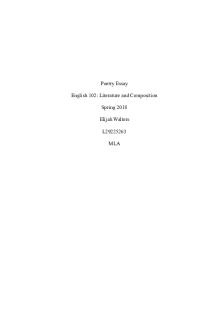Ho K Essay - Grade: B PDF

| Title | Ho K Essay - Grade: B |
|---|---|
| Course | History of Kazakhstan |
| Institution | Назарбаев Университеті |
| Pages | 7 |
| File Size | 156.7 KB |
| File Type | |
| Total Downloads | 24 |
| Total Views | 144 |
Summary
An essay on rebellions in Kazakhstan between 18th and 19th century...
Description
Zharkynbay Talgat. ID: 201411703
Whywe r et he r es oma n yr e be l l i o nsi nt hel a t e1 8th-a nde a r l y1 9thc e nt ur yKa z a khs t e ppe ?
For every action there will be a reaction. Or, it is possible to say that any action will lead to certain consequences. A big number of revolts in Kazakh steppe in the late 18th and early 19th century is also a reaction to the certain sequence of events and decisions. It is often argued that frequent rebellions in that period were triggered by the aggressive imperial policy used by Russian Empire against Kazakh people. The diplomacy between Kazakhs and Russian Empire has always been complex. The beginning of close relationships is dated on 10th of October 1731, when Abulkhair, Khan of the Kazakh Junior Horde gave his oath of allegiance to Russian Empress Anna Ioannovna. According to Bodger (1980, 46): "The Kazakhs promised to protect Russian borders, to serve when needed, to pay tribute and to protect Russian trade caravans to Central Asian oases." In this essay, I will analyze the Russian Empire's policy towards the Kazakh Steppe after the oath of Abulkhair Khan, and argue that because of its aggressive imperial character and corruption among the feudal elite of Kazakhs the big number of rebellions happened in the early 18th and late 19th century. I will attempt to prove that Russian Empire's policy was aggressively imperial by demonstrating evidence that Russia was building cities and fortresses on Kazakh territory, limiting Khan's authority, putting boundaries for nomadic lifestyle and imposing taxes on Kazakhs. The corruption, greediness and egoism among Kazakh feudals like Zhangir Khan will be also discussed as one of the stimulus for discontent among peasants. The historical data about Srym Batyr, Isatay Taimanuly and Makhambet Otemisuly, Zholaman Tleushiuly, Gubaidulla khan, Kenesary Kasymov and their rebellions will be evaluated to prove the point that Russian imperial policy and feudalism were the main reasons for a big number of revolts in the given period. Firstly, in order to argue that it was Russian imperial policy that triggered rebellions, it is necessary to prove that the policy was actually imperialistic. It is necessary to determine what
Zharkynbay Talgat. ID: 201411703
factors make the policy "imperial". Oxford Dictionary (2016) defines the word imperialism as "Apolicy of extending a country’s power and influence through colonization, use of military force, or other means" After October 1731, Russian Empire started to gradually increase its influence in the territory of the Junior Horde. In order to realize its imperialism policy to the territory of the Kazakh Junior Horde territory, Russian Empire used the strategy of constant military pressure and forging alliances with Kazakh feudals like sultans, biis and the Khan himself in order to make them obedient and use them as executor's of tsarist regime (Zimanov 1982, 14). In 1756, Russian Empire issued the decree that declared the right bank of Ural as Russian territory (Zimanov 1982, 15). Clearly, the Russian policy was imperial, because the borders were expanding further and further to the territory of the Junior Horde. Russian policy towards Kazakh elite separated Khan and his sultans from lower orders, Khan and his sultans acted only as agents of tsarist regime, they were not the representatives of the Kazakh people any more. As it was mentioned before, Russia used the strategy of controlling the feudal elite of Kazakhs and decreasing the power of Khan, that is why, Nuraly Khan and the feudal elite of Kazakhs were given the permission to occupy the favourable territories near Ural and Yaik rivers in 1758 and 1757 (Zimanov 1982, 22). The richest part of Kazakh population, including Khan pursued only their self-interest in their negotiations with Russian Empire. For a certain period, only Khan's relatives were allowed to occupy favourable pastures. The late 18th century and early 19th century can be described as one of the most difficult periods in the history of the Junior Horde, because the economical and societal conditions were extremely poor. Russian Empire was sending squads that devastated villages of peasants, the same actions were done by the Kazakh feudals (Zimanov 1982, 16). The situation was worsened by jutes in 1795 and 1800, the Kazakh peasants have reached the level of poverty when they were obliged to sell their own children for meal (Levshin, quoted in Zimanov 1982, 13). The Khanship's influence towards lower orders has fallen dramatically, the background of poverty, corruption, disorders and
Zharkynbay Talgat. ID: 201411703
internecine "baranta" (theft of livestock or over property) lead to mass discontent among Kazakhs of Junior Horde. Batyr Srym's revolt from 1783 to 1797 is one of the consequences of the rickety situation in the late 19th century, the revolt's primary aim was to tackle with the Khan's and sultans policies towards impoverished peasants.(Zimanov 1982, 12). The exploitation of masses and Srym Batyr's revolt contributed to the assassination of the Esim Khan in 1797, and the so-called "Khanskiy Sovet" was introduced by the Russian rule. (Zimanov 1982, 13). This is not to say that the creation of the "Khanskiy Sovet" was the direct consequence of the revolt, but, clearly it was another tool that diminished the Khan's authority and eased task of Kazakh Steppe control. The aged sultan Aichuvak was appointed as a Khan, but the council was ineffective(Zimanov 1982, 13). Bukei Sultan that was loyal to Russian rule was also appointed as one of the administrators of the "Khanskiy Sovet". In fact, Russian Empire used Tatars as intermediaries in order to control Kazakh steppe, Tatars sometimes serves as spies for Russia (Frank, 272). It is not surprising that Tatar muftis were serving as administrators in the "Khanskiy Sovet" ( Zigadullin, 2011). In 1801, the Bukei Khanate was created, and Kazakhs were allowed to settle on the west side of Ural river permanently, but this was not of any help for lower orders. Russian Empire's strategy to decrease the power of Kazakh elite continued, in 1822 Proclamation of the Statute on Siberian Kirgizes was declared by Russian government. The goal of the statue was to create the centralized administration in the Kazakh steppe: "On the occasion of this wish, our All-Merciful Emperor, with sincere conviction, hopes that [. . .] with the announcement of this statute and in its organization there will be only unified order among the Kirgiz people, and that internecine warfare and baranta will be done away with..." (Ross and Kussainova, 122). It may be argued that the statue had progressive consequences for Kazakh people (Mukanov 1991). But, the 1822 and 1824 statues completely abolished the Khanship system in the Junior and Middle Hordes respectively (Bekmahanov 1992, 14). Gubaidulla Khan, who has the last Khan of the Middle Horde, was dissatisfied with this decision of Russian
Zharkynbay Talgat. ID: 201411703
government and started revolt against tsarist regime in 1824, his rebellion was crushed in 1825. Gubaidulla Khan was exiled to Siberia (Kozybaev 1991). Zhangir Khan used his position to assign himself about 400,000 acres of land and rent it to peasants (Kozybaev 1992, 8). Moreover, Kazakh lower orders in the Bukei Khanate were strictly penalized by feudals for occupation of lands that belonged to authorities. For instance, in 1813 Ural Office confiscated the lands around Kamysh-Samara lake that previously was occupied by Kazakh lower orders, the territory was transferred to Karaul Babazhanov, the sultan and father in law of Zhangir Khan (Kozybaev 1992, 8). According to the data from Orenburg Boundary Commission, in the period between 1830 and 1845, Zhangir Khan has signed about 1500 deeds about land ownership. Zhangir Khan himself owned favorable land around the Torgun river, Karaul Babazhanov owned 700,000 acres of land around Caspian Sea, Chingalii and Muchigalii also got 700,000 acres of land. This land theft actions eventuated with that only one third of the Bukei Khanate territory belonged to Kazakh "sharua" (group of dependent pastoralists and farmers). Two thirds of the land were considered as a private property and was rented out by Kazakh Elite (Ryazanov 1927, 9). Islam and taxation also can be considered as one of the key factors that were contributive to the big number of rebellions. There is a document that is dated on December 12, 1811 called "Прошение султана Букея министру иностранных дел, канцлеру графу Н.П Румянцеву о причислении к Внутренней орде татарских мулл." (Erofeeva 2002, 12). Tatar mullahs became a part of Bukei Horde, the Islamization process became more integrated. And Khan Zhangir Khan imposed two types of Islamic taxation on Kazakh peasants. According to Ryazanov (1992, 10): "Нам уже известно, что хан взимал два вида налогов: зякет, как обычный государственный налог, и сугум- на содержание ханской ставки." The feudalization amplification process and Islamic taxation triggered unrest and discontent among Kazakh "sharua" the Isatay Taimanuly and Makhambet Otemisuly in 1836 is one of the brightest flashes of discontent with Russian imperialism and feudalism by Kazakh elite, particularly by Zhangir
Zharkynbay Talgat. ID: 201411703
Khan (Kozybaev 1992, 10). Isatay Taimanuly's rebel squad has became the last hope for those who were oppressed by the Khan, sultans and biis (Kozybaev 1992, 18). The problem of land and culture was less significant, but also was very contributive to the Isatay Taimanuly's rebellion. Previously, Kazakh people used to nomadize freely across the steppe, cattle breeding was the core component of their lives. The sedentary lifestyle, and feudal system that substituted the tribal system were hardly accepted by ingrained nomadic pastoralists, the discontent and panic among peasants appeared because of the gossip about compulsory military service, increase in tax rates, cut of the territory. The emersion of Russian fortresses, cities, border lines and the so-called "Дистанционная Система" that was introduced in Junior Horde in 1831 has shaken the faith in the idea that allegiance to Russian Empire will lead to prosperity for Kazakh people (Ryazanov 1927, 9). Zholaman Tleunshiuly's revolt in 1820's was one of the signs of land problem in Kazakh Steppe (Bekmahanov 1992, 8). In 1835, the socalled "New Line" of fortifications was built, eventually lands of Kazakh people of Junior Horde were confiscated. In 1837, "правительство приступило к обложению казахов постоянной податью. Был введен так называемый кибиточный сбор, который должны были уплачивать все казахи.." (Bekmahanov 1992, 5). Russian forces started to plunder Kazakh villages even more tightly than before. Russian government called this actions "military search" and justified it, by demonstrating it as a search for Kazakh criminals. The human trafiicking of Kazakh children was gaining its popularity, moreover it was legalized by the special law of Alexander I (Bekmahanov 1992, 7). Kenesary Kasymov's revolt from 1837 to 1847 is considered as the most massive and centralized revolt again Russian authority and their representatives, Kazakh feudals. The fact, that Junior, Middle and Great Horde united together demonstrates resoluteness and anger of Kazakhs. Kenesary Kasymov continued the deeds of Batyr Srym and Isatay Taimanuly, the factors that started Kasymov's revolt were almost no different from the factors that started previous rebellions: the robbing of pastoralists and lower orders, confiscation of land, taxes, pressure of border lines.
Zharkynbay Talgat. ID: 201411703
It can be conclusion, the Russian government policies in 18th and 19th centuries were analyzed. Undoubtedly, Russian imperial policy towards Kazakh Steppe has brought a big number of changes to the life of nomads. Kazakh people had to turn away from the nomadic way of life, and turn to sedentary lifestyles. Taxes, land confiscation and feudal system, removal of Khanship system are also attributed as changes brought by Russian government and their Kazakh agents. Probably, new systems were introduced to quickly, Kazakhs responded to those changes through rebellions. Nevertheless, it was proved that all major rebellions in the Kazakh Steppe in the late 18th and early 19th century were triggered by the actions of Russian Empire and Kazakh feudals that became dependent on Russian government.
Zharkynbay Talgat. ID: 201411703
Reference List:
Apollova, N. Присоединение Казахстана к России. Almaty, 1948.
Bekmakhanov, A. Восстание Хана Кенесары (1837-1847). Almaty, 1992.
Bodger, Alan. "Abulkhair, Khan of the Kazakh Little Horde, and." Modern Humanities Research Association and University College London 58, no. 1, 40-57. Accessed July 03, 2016.
Erofeeva. История Букеевского ханства. 1801-1852 гг. Сборник документов и материалов. Almaty, 2002.
Frank, Allen. The Islamic Transformation on the Kazakh Steppe, 1742-1917: Toward an Islamic History of Kazakhstan under Russian Rule.
Ma r a tMu ka no v, Этн ич е с к а яте р ри тор ияКз а х овв18 м– на ч ал е20 хв е к ов .Al ma t y .19 91
Kozybayev, K. Народно-Освободительное Движение Казахов в 1836-1838 годах. 1992.
Kozybayev, K. Народно-Освободительное Движение в условиях колониализма. 1991
Ross and Kusainova. Nomadic Societies after the Mongol Empire.
Ryazanov, A. Восстание Исатая Тайманова. 1927.
Shoinbaev, T. Прогрессивное значение присоединения Казахстана к России. Almaty, 1973.
Oxforddictionaries.com. (2016). imperialism - definition of imperialism in English from the Oxford dictionary. http://www.oxforddictionaries.com/definition/english/imperialism Accessed 3 Jul. 2016.
Zigadullin and etc (eds.) Orenburgskoe magometanskoe dukhovnoe sobranie i dukhovnoe razvitie tatarskogo naroda v poslednei chetverti XVIII - nachale XX vv. Kazan, 2011.
Zimanov, S. Россия и Букеевское Ханство. Almaty, 1982....
Similar Free PDFs

Ho K Essay - Grade: B
- 7 Pages

Rogerian Essay - Grade: B
- 2 Pages

Zoo Essay - Grade: B+
- 2 Pages

Causation Essay - Grade: B
- 4 Pages

Final Essay - Grade: B+
- 12 Pages

Propaganda Essay - Grade: b
- 4 Pages

Poetry Essay - Grade: B
- 5 Pages

Galileo Essay - Grade: B+
- 6 Pages

Fiction Essay - Grade: B
- 7 Pages

EPQ Essay - Grade: B+
- 10 Pages

Law essay - Grade: B
- 9 Pages

Persuasive Essay - Grade: B
- 3 Pages

Evicted Essay - Grade: B+
- 3 Pages

Charities essay - Grade: B+
- 13 Pages

Reflective Essay - Grade: B
- 4 Pages

Analysis essay - Grade: B+
- 3 Pages
Popular Institutions
- Tinajero National High School - Annex
- Politeknik Caltex Riau
- Yokohama City University
- SGT University
- University of Al-Qadisiyah
- Divine Word College of Vigan
- Techniek College Rotterdam
- Universidade de Santiago
- Universiti Teknologi MARA Cawangan Johor Kampus Pasir Gudang
- Poltekkes Kemenkes Yogyakarta
- Baguio City National High School
- Colegio san marcos
- preparatoria uno
- Centro de Bachillerato Tecnológico Industrial y de Servicios No. 107
- Dalian Maritime University
- Quang Trung Secondary School
- Colegio Tecnológico en Informática
- Corporación Regional de Educación Superior
- Grupo CEDVA
- Dar Al Uloom University
- Centro de Estudios Preuniversitarios de la Universidad Nacional de Ingeniería
- 上智大学
- Aakash International School, Nuna Majara
- San Felipe Neri Catholic School
- Kang Chiao International School - New Taipei City
- Misamis Occidental National High School
- Institución Educativa Escuela Normal Juan Ladrilleros
- Kolehiyo ng Pantukan
- Batanes State College
- Instituto Continental
- Sekolah Menengah Kejuruan Kesehatan Kaltara (Tarakan)
- Colegio de La Inmaculada Concepcion - Cebu